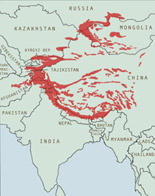Uzbekistan represents the extreme western area of snow leopard range and the country has the smallest population of any of the range countries.
Range and population

First ever snow leopards captured on remote camera in Uzbekistan. 2014 (c) Y. Protas/Panthera/WWF Central Asia Program/Uzbek Biocontrol Agency/Gissar Nature Reserve.
The snow leopard in Uzbekistan occurs in the Western Tien – Shan mountain ranges and also in the Pamir-Alai mountains. The range area is only around 10,000 square kilometres representing 0.5% of the total snow leopard global range. The current estimate for the number of snow leopards is at 20-50 individual cats, which is less than 1% of the global population.
The first camera trapped snow leopards were reported in 2014 in Gissar State Reserve Prey
Snow leopard prey in Uzbekistan
The following animals have been found to be prey for the small population of snow leopards in Uzbekistan. Siberian Ibex, Menzbier’s Marmot, Red Pika, hare, and birds like the Himalayan Snow Cock.
Threats to snow leopards in Uzbekistan
Snow leopards in Uzbekistan have faced significant threats in the last 50 years. During the 1990’s decade significant poaching of snow leopards occurred motivated by economic insecurity after the collapse of the former Soviet Union. Evidence suggests that even wildlife guards took part in snow leopard poaching and selling of pelts and bones. During that time it was estimated that as many as ten snow leopards were killed each year.
Today threats continue, mainly –
- Human wildlife conflict
- Habitat degradation
- Prey reduction du to illegal hunting
- Competition with livestock
- Poaching for trade in hide and bones
- Lack of effective enforcement, institutional capacity and trans boundary co-operation
- Human poverty
- Climate change.
Conservation Action
Uzbekistan has identified it has much work to do to protect their extremely small population of snow leopards and to stop the species becoming extinct in their country. Uzbekistan has identified the need to update the Strategy and National Action Plan for the Conservation of Snow Leopards. As part of the Global Snow Leopard and Ecosystem Protection Program (GSLEP), Uzbekistan authorities are working on the development and implementation of regulations to protect the snow leopard and the appointment of groups responsible for its conservation.
The Snow leopard is legally protected in Uzbekistan under the Law on Nature Protection of 1993 and the species is included in the Red Book of Uzbekistan (2009). There are significant fines and prison terms for poaching. However poachers are rarely caught due to lack of enforcement, insufficient ranger staff and protected area wardens.
In 2004 the Uzbekistan Academy of Science, the State Committee for Nature protection and the Snow Leopard Trust developed the Strategy for Snow Leopard Conservation in Uzbekistan. (GSLEP October 2013).
Actions identified to support snow leopard conservation in Uzbekistan are resolution of herder conflict, public awareness and education programs, introduction of ecotourism income for local communities and increase protection against illegal hunting. Also trans boundary co-operation and collaboration with Kazakhstan, Kyrgyzstan and Tajikistan has been identified as important.
Panthera, WWF, Uzbekistan BioControl Agency
During late 2013, a team of rangers and biologists led by Bakhtiyor Aromov and Yelizaveta Protas, in collaboration with Panthera, WWF Central Asia Program and Uzbekistan BioControl Agency, conducted a snow leopard camera trap study in the Kizilsu area of Gissar Nature Reserve, on the border of Uzbekistan and Tajikistan.
The first ever images of snow leopards in Uzbekistan were taken at this time and confirmed the presence of at least two snow leopards in this region, along with other large predators, lynx and bear. Situated on the western edge of the Pamir mountain range, the Gissar Nature Reserve is the largest protected area in Uzbekistan and now guarded by border patrols and reserve rangers, with visitors allowed only for scientific research.
Global Environment Facility (GEF)
The GEF West Tien Shan project (2005-2009) aimed to improve and increase cooperation between five Protected Areas (Pas), all of which hold snow leopards. They were the Chatkal State Reserve in Uzbekistan, Sary-Chelek and Besh-Aral Special Reserve in Kyrgyzstan along with Aksu-Djabagly Special Reserve in Kazakhstan. The aim was to strengthen institutional capacity and national policies, supporting trans boundary regional cooperation, and help generate income for herders and others living with the PAs.




